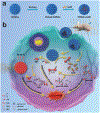Fe3O4 Nanoparticles: Structures, Synthesis, Magnetic Properties, Surface Functionalization, and Emerging Applications
- PMID: 35844268
- PMCID: PMC9285867
- DOI: 10.3390/app112311301
Fe3O4 Nanoparticles: Structures, Synthesis, Magnetic Properties, Surface Functionalization, and Emerging Applications
Abstract
Magnetite (Fe3O4) nanoparticles (NPs) are attractive nanomaterials in the field of material science, chemistry, and physics because of their valuable properties, such as soft ferromagnetism, half-metallicity, and biocompatibility. Various structures of Fe3O4 NPs with different sizes, geometries, and nanoarchitectures have been synthesized, and the related properties have been studied with targets in multiple fields of applications, including biomedical devices, electronic devices, environmental solutions, and energy applications. Tailoring the sizes, geometries, magnetic properties, and functionalities is an important task that determines the performance of Fe3O4 NPs in many applications. Therefore, this review focuses on the crucial aspects of Fe3O4 NPs, including structures, synthesis, magnetic properties, and strategies for functionalization, which jointly determine the application performance of various Fe3O4 NP-based systems. We first summarize the recent advances in the synthesis of magnetite NPs with different sizes, morphologies, and magnetic properties. We also highlight the importance of synthetic factors in controlling the structures and properties of NPs, such as the uniformity of sizes, morphology, surfaces, and magnetic properties. Moreover, emerging applications using Fe3O4 NPs and their functionalized nanostructures are also highlighted with a focus on applications in biomedical technologies, biosensing, environmental remedies for water treatment, and energy storage and conversion devices.
Keywords: Fe3O4 nanoparticles; biomedical applications; biosensing; core-shell structures; energy storage; environmental applications; magnetic properties; nanocomposites; surface functionalization.
Conflict of interest statement
Conflicts of Interest: The authors have no competing financial interest to declare.
Figures












References
-
- Jeong U; Teng X; Wang Y; Yang H; Xia Y Superparamagnetic Colloids: Controlled Synthesis and Niche Applications. Adv. Mater 2007, 19, 33–60.
-
- Lu A-H; Salabas EL; Schüth F Magnetic Nanoparticles: Synthesis, Protection, Functionalization, and Application. Angew. Chem. Int. Ed 2007, 46, 1222–1244. - PubMed
-
- Singamaneni S; Bliznyuk VN; Binek C; Tsymbal EY Magnetic Nanoparticles: Recent Advances in Synthesis, Self-Assembly and Applications. J. Mater. Chem 2011, 21, 16819–16845.
-
- Lisjak D; Mertelj A Anisotropic Magnetic Nanoparticles: A Review of Their Properties, Syntheses and Potential Applications. Prog. Mater. Sci 2018, 95, 286–328.
Grants and funding
LinkOut - more resources
Full Text Sources
Other Literature Sources
Miscellaneous
